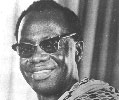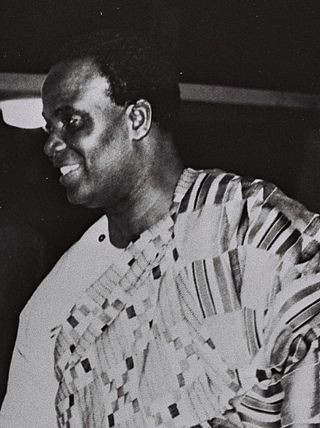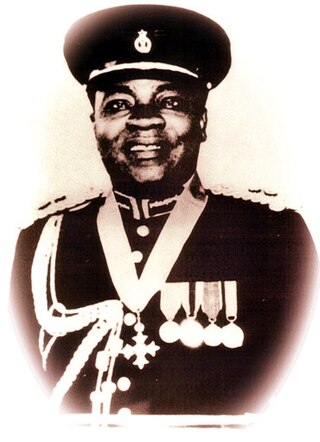Related Research Articles
Guy Warren of Ghana, also known as Kofi Ghanaba, was a Ghanaian musician, most notable as the inventor of Afro-jazz — "the reuniting of African-American jazz with its African roots" — and as a member of The Tempos, alongside E. T. Mensah. He also inspired musicians such as Fela Kuti. Warren's virtuosity on the African drums earned him the appellation "The Divine Drummer". At different stages of his life, he additionally worked as a journalist, DJ and broadcaster.

Kofi Abrefa Busia was a Ghanaian political leader and academic who was Prime Minister of Ghana from 1969 to 1972. As a leader and prime minister, he helped to restore civilian government to the country following military rule.

Kwame Nkrumah University of Science and Technology (KNUST), commonly known as UST, Tech or Kwame Tech, is a public university located in Kumasi, Ashanti region, Ghana. The university focuses on science and technology. It is the second public university established in the country, as well as the largest university in the Ashanti Region of Ghana.

Kojo Botsio was a Ghanaian diplomat and politician. He studied in Britain, where he became the treasurer of the West African National Secretariat and an acting warden for the West African Students' Union. He served as his country's first Minister of Education and Social Welfare from 1951, as Minister for Foreign Affairs twice in the government of Kwame Nkrumah, and was a leading figure in the ruling Convention People's Party (CPP).

Achimota School, formerly Prince of Wales College and School at Achimota, later Achimota College, now nicknamed Motown, is a co-educational boarding school located at Achimota in Accra, Greater Accra, Ghana. The school was founded in 1924 by Sir Frederick Gordon Guggisberg, Dr. James Emman Kwegyir Aggrey and the Rev. Alec Garden Fraser. It was formally opened in 1927 by Sir Guggisberg, then Governor of the British Gold Coast colony. Achimota, modelled on the British public school system, was the first mixed-gender school to be established on the Gold Coast.
El Anatsui is a Ghanaian sculptor active for much of his career in Nigeria. He has drawn particular international attention for his "bottle-top installations". These installations consist of thousands of aluminum pieces sourced from alcohol recycling stations and sewn together with copper wire, which are then transformed into metallic cloth-like wall sculptures. Such materials, while seemingly stiff and sturdy, are actually free and flexible, which often helps with manipulation when installing his sculptures.

Erasmus Ransford Tawiah Madjitey, was a Ghanaian police officer, diplomat and politician. He was appointed Police Commissioner in the Dominion of Ghana on 9 October 1958, making him not only the first Ghanaian to head the Ghana Police Service, but also the first African south of the Sahara and in the British Commonwealth to command a police force.
Herman "Kofi" Bailey (1931–1981) was an African-American artist. He was best known for his conté and charcoal drawings reflecting of the African-American experience.

James Barnor Hon. FRPS, OV is a Ghanaian photographer who has been based in London since the 1990s. His career spans six decades, and although for much of that period his work was not widely known, it has latterly been discovered by new audiences. In his street and studio photography, Barnor represents societies in transition in the 1950s and 1960s: Ghana moving toward independence, and London becoming a multicultural metropolis. He has said: "I was lucky to be alive when things were happening...when Ghana was going to be independent and Ghana became independent, and when I came to England the Beatles were around. Things were happening in the 60s, so I call myself Lucky Jim." He was Ghana's first full-time newspaper photographer in the 1950s, and he is credited with introducing colour processing to Ghana in the 1970s. It has been said: "James Barnor is to Ghana and photojournalism what Ousmane Sembène was to Senegal and African cinema."
Theodosia Salome Okoh was a Ghanaian teacher and artist known for designing Ghana's national flag in 1957. She exhibited her artwork internationally. She also played a leading role in the development of hockey in Ghana. Her grandson is Ian Jones-Quartey, creator of OK K.O.! Let's Be Heroes, and her granddaughter-in-law is Rebecca Sugar, creator of Steven Universe.
Atukwei John Okai was a Ghanaian poet, cultural activist and academic. He was Secretary-General of the Pan African Writers' Association, and a president of the Ghana Association of Writers. His early work was published under the name John Okai. With his poems rooted in the oral tradition, he is generally acknowledged to have been the first real performance poet to emerge from Africa, and his work has been called "also politically radical and socially conscious, one of his great concerns being Pan-Africanism". His performances on radio and television worldwide include an acclaimed 1975 appearance at Poetry International at Queen Elizabeth Hall in London, where he shared the stage with US poets Stanley Kunitz and Robert Lowell, and Nicolás Guillén of Cuba.
Ablade GloverCV is a Ghanaian painter and educator. He has exhibited widely, building an international reputation over several decades, as well as being regarded as a seminal figure on the West African art scene. His work is held in many prestigious private and public collections, which include the Imperial Palace of Japan, the UNESCO headquarters in Paris, France, and O'Hare International Airport, Chicago, United States.
Bright Tetteh Ackwerh is a Ghanaian satirical artist who employs the domains of popular art, street art, painting, and illustration to voice and document his persuasions. He has exhibited widely in Ghana and West Africa, building a niche as an emerging contemporary Ghanaian artist on the West African art scene.
Atta Kwami was a Ghanaian painter, printmaker, independent art historian and curator. He was educated and taught at the Kwame Nkrumah University of Science and Technology (KNUST), Kumasi, Ghana, and in the United Kingdom. He created works that improvise form and colour and speak to uniquely Ghanaian architecture and African strip-woven textiles, including those of the Kente, the Ewe and Asante of Ghana.

Shatta Rako is a Ghanaian dance hall and afrobeats musician, graphic designer and the CEO of Legend Studios.
David Kwaku Ziga (1922–?), was a Ghanaian politician and potter. He was a member for parliament for the Afadzato constituency from 1965 to 1966, he was also the managing proprietor of Ziga Pottery and Ceramic Works.
Robert Joseph Mettle-Nunoo also known as Rojo Mettle Nunoo is Ghanaian contemporary artist and politician. He is a member of the National Democratic Congress and served as the Deputy Minister of Health during the John Evans Atta Mills government.
Kobina Bucknor (1925–1975) was a Ghanaian animal scientist and painter.
Vincent Akwete Kofi (1923–1974) was a Ghanaian artist and academic known for his modernist sculpture, which was inspired by themes such as Pan-Africanism and decolonization. He was described as "Ghana's most important sculptor".
Kofi Setordji is a multidisciplinary visual artist based in Ghana. His works range from graphic design, textile designing, sculpture and painting.
References
- 1 2 3 4 5 6 7 8 Woets, Rhoda (2014). "THE RECREATION OF MODERN AND AFRICAN ART AT ACHIMOTA SCHOOL IN THE GOLD COAST (1927–52)". The Journal of African History. 55 (3): 445–465. doi:10.1017/S0021853714000590. ISSN 0021-8537.
- 1 2 3 4 5 Kwami, Atta (2013). "Kofi Antubam, 1922-1964". A Companion to Modern African Art. Oxford: John Wiley & Sons, Ltd. pp. 218–236. doi:10.1002/9781118515105.ch11. ISBN 9781118515105.
- ↑ Woets, Rhoda (2016), "Antubam, Kofi (1922–1964)", Routledge Encyclopedia of Modernism (1 ed.), London: Routledge, doi:10.4324/9781135000356-rem756-1, ISBN 978-1-135-00035-6 , retrieved 2023-11-10
- 1 2 Crabbe, Nathaniel (2020-07-16). "Meet Kofi Antubam, the artist who pioneered modern art in Ghana". Yen.com.gh - Ghana news. Retrieved 2023-11-10.